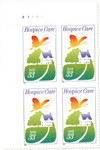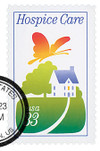
# 3276 - 1999 33c Hospice Care
US #3276
1999 Hospice Care
- Honors the hospices of the United States which care for terminally ill patients and their families
Stamp Category: Commemorative
Value: 33¢ First Class Mail Rate
First Day of Issue: February 9, 1999
First Day City: Largo, Florida
Quantity Issued: 100,000,000
Printed by: Banknote Corporation of America
Printing Method: Offset
Format: Panes of 20 (Self-adhesive)(Vertical 5 across, 4 down)
Perforations: 11.4 (Die-cut simulated perforations)
Tagging: Phosphored Paper
Why the stamp was issued: Honors hospices across America taking care of countless terminally ill patients and providing critical support to their families.
About the stamp design: Designed by USPS art director Phil Jordan. Pictures a house with purple roof and a yellow light in one of its windows, a curved white walkway cutting through a green lawn. Behind the house is a large tree. Over the entire scene is a large red and yellow butterfly and the words “Hospice Care.” Jordan previously worked on logos for several hospices and had a personal connection to the service as they helped care for several of his family members. He said, “Those people were indispensable – so levelheaded and good to us. They were saints.” Jordan began the design with colored pencil sketches and finished them digitally.
Special design details: Jordan said “The stamp art symbolizes life’s journey to its final stage. The use of color gradation is an attempt to convey transition through the stages of life unil we come home to death.”
First Day City: The First Day of Issue Ceremony was held in Largo, Florida at The Hospice of the Florida Suncoast. Some other hospice programs held their own special ceremonies with their own unique cancellations and cachets.
History the stamp represents: There are thousands of hospice organizations serving hundreds of thousands of people in the United States and Puerto Rico. By combining the efforts of skilled workers and trained volunteers, hospice has become a family-centered, home-based concept of health care for those dying of an incurable illness.
Hospice was first introduced in this country by Dr. Cicely Saunders, who established St. Christopher’s Hospice in London. In 1974, a nurse in Connecticut made America’s first hospice visit to the home of a terminally ill patient.
The hospice concept aims at easing the patient’s physical and psychological pain. Then the person can make the most of his or her remaining time. Working as a team to achieve this goal are family members, doctors, nurses, social workers, clergy members, and volunteers.
In 1980, a hospice was established in Glasgow as a community outreach project. On the occasion of the marriage of Prince Charles and Lady Diana Spencer in 1981, the city of Glasgow named the foundation the Prince and Princess of Wales Hospice. A tireless charity worker, Princess Diana used her sudden celebrity to fight for the causes she believed in, including care of terminally ill patients.
US #3276
1999 Hospice Care
- Honors the hospices of the United States which care for terminally ill patients and their families
Stamp Category: Commemorative
Value: 33¢ First Class Mail Rate
First Day of Issue: February 9, 1999
First Day City: Largo, Florida
Quantity Issued: 100,000,000
Printed by: Banknote Corporation of America
Printing Method: Offset
Format: Panes of 20 (Self-adhesive)(Vertical 5 across, 4 down)
Perforations: 11.4 (Die-cut simulated perforations)
Tagging: Phosphored Paper
Why the stamp was issued: Honors hospices across America taking care of countless terminally ill patients and providing critical support to their families.
About the stamp design: Designed by USPS art director Phil Jordan. Pictures a house with purple roof and a yellow light in one of its windows, a curved white walkway cutting through a green lawn. Behind the house is a large tree. Over the entire scene is a large red and yellow butterfly and the words “Hospice Care.” Jordan previously worked on logos for several hospices and had a personal connection to the service as they helped care for several of his family members. He said, “Those people were indispensable – so levelheaded and good to us. They were saints.” Jordan began the design with colored pencil sketches and finished them digitally.
Special design details: Jordan said “The stamp art symbolizes life’s journey to its final stage. The use of color gradation is an attempt to convey transition through the stages of life unil we come home to death.”
First Day City: The First Day of Issue Ceremony was held in Largo, Florida at The Hospice of the Florida Suncoast. Some other hospice programs held their own special ceremonies with their own unique cancellations and cachets.
History the stamp represents: There are thousands of hospice organizations serving hundreds of thousands of people in the United States and Puerto Rico. By combining the efforts of skilled workers and trained volunteers, hospice has become a family-centered, home-based concept of health care for those dying of an incurable illness.
Hospice was first introduced in this country by Dr. Cicely Saunders, who established St. Christopher’s Hospice in London. In 1974, a nurse in Connecticut made America’s first hospice visit to the home of a terminally ill patient.
The hospice concept aims at easing the patient’s physical and psychological pain. Then the person can make the most of his or her remaining time. Working as a team to achieve this goal are family members, doctors, nurses, social workers, clergy members, and volunteers.
In 1980, a hospice was established in Glasgow as a community outreach project. On the occasion of the marriage of Prince Charles and Lady Diana Spencer in 1981, the city of Glasgow named the foundation the Prince and Princess of Wales Hospice. A tireless charity worker, Princess Diana used her sudden celebrity to fight for the causes she believed in, including care of terminally ill patients.












